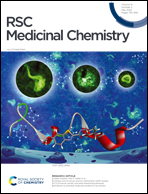Titanium complexes affect Bacillus subtilis biofilm formation†
Abstract
Biofilms are surface or interface-associated communities of bacterial cells, embedded in a self-secreted extracellular matrix (ECM). Cells in biofilms are 100–1000 times more resistant to antibiotic treatment relative to planktonic cells due to various reasons, including the ECM acting as a diffusion barrier to antibiotic molecules, the presence of persister cells that divide slowly and are less susceptible to cell-wall targeting drugs, and the activation of efflux pumps in response to antibiotic stress. In this study we tested the effect of two titanium(IV) complexes that have been previously reported as potent and non-toxic anticancer chemotherapeutic agents on Bacillus subtilis cells in culture and in biofilm forming conditions. The Ti(IV) complexes tested, a hexacoordinate diaminobis(phenolato)-bis(alkoxo) complex (phenolaTi) and a bis(isopropoxo) complex of a diaminobis(phenolato) “salan”-type ligand (salanTi), did not affect the growth rate of cells in shaken cultures, however they did affect biofilm formation. Surprisingly, while phenolaTi inhibited biofilm formation, the presence of salanTi induced the formation of more mechanically robust biofilms. Optical microscopy images of biofilm samples in the absence and presence of Ti(IV) complexes suggest that Ti(IV) complexes affect cell–cell and/or cell–matrix adhesion, and that these are interfered with phenolaTi and enhanced by salanTi. Our results highlight the possible effect of Ti(IV) complexes on bacterial biofilms, which is gaining interest in light of the emerging relations between bacteria and cancerous tumors.



 Please wait while we load your content...
Please wait while we load your content...